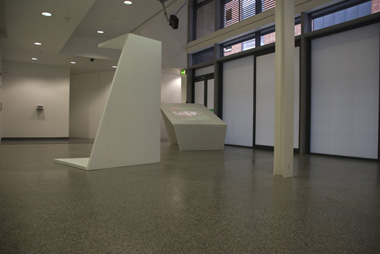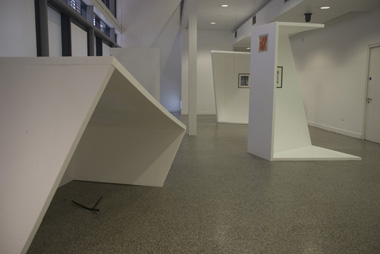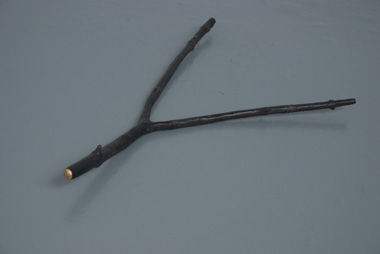I arrived at The Lab for the opening of Lee Welch’s latest endeavour – a solo show entitled Never odd or even – enthusiastically prepared to absolutely detest it. Unfamiliar with much of his previous work, and unable to claim him as even a casual acquaintance, my judgement was impossibly coloured by the recent and annoying ubiquity of the man himself. Few will argue that Welch seems to be everywhere at the moment, popping up in group shows from Blandschardstown to Claremorris. While he’s not making weird, ephemeral art, winning awards, or being granted funding, he is founding and directing exciting new Dublin gallery spaces. Welch may well transpire to be the Mother Teresa of the contemporary Irish art scene in person, but I didn’t care. My preconceptions were already tarnished by obscene envy. With a CV as long one of the ropes used in the Indian trick he is so fond of referencing, Welch is undoubtedly the man that every aspiring or struggling arts practitioner should quite justifiably love to hate.
Despite my fervent scepticism, having encountered a few of Welch’s pieces in group exhibitions around Dublin recently (Based on our current science at the Gallery of Photography and Non-knowledge at the Project Arts Centre), I was genuinely curious to see how an entire show devoted to multiple Welches would hold water. The Lab exhibition is a development of his NCAD Degree Show, which originally took place on campus, in one of the cramped, makeshift spaces annually allocated for students. Like a caged mammal released into a meadow, Welch has gallivanted about The Lab’s main gallery, gleefully scattering a whirlwind of random narratives and complicated notions, uniting found media with minimal sculpture and projected film.
Geometric polystyrene constructions (built collaboratively with Ken Meehan and Jeanette Doyle) punctuate the floor, towering above the viewer in some cases, and sweeping below in others. The flimsy structures both obscure and architecturally intervene – providing armatures for framed images, flat surfaces for film projection, or shelters for discreet objects. There is a bookshelf, in which the books are the shelf, and a gentle video piece on water divining positioned low down in a corner, accompanied by a sound-piece accessible through the privacy of headphones. A film adaptation of D H Lawrence’s famous 1928 novel, Lady Chatterly’s lover, flickers across a polystyrene surface. The porch space left of the entrance to The Lab is the perfect place to house the tall and slender abstract aluminium pole entitled Between the essence and the descent, falls the shadow. All of Welch’s titles are similarly enigmatic in tone – Its results are its own witness; The suspense of disbelief; A suspicious affinity. I was confused and reluctantly intrigued in equal measure.
I left the opening a little disconcerted, but generally satisfied that Welch was spreading himself too thin, and as a result, the work came across as unappealing in appearance and vapid in content.
Almost a full day later, I stumbled across the crumpled exhibition publication in the bottom of my rucksack. I read it instantly, cover to cover, unexpectedly absorbed. Paying attention to the texts and details and explanations revealed that my earlier dismissal of the work represented a significant injustice. When I had finished reading, I found myself irresistibly twisting and bending the binding of the little catalogue about, determined to discover some hidden thing concealed within its unusual design. It was then that I realised how Welch had succeeded in getting under my skin. I felt strangely compelled to look beyond and un-necessarily question that which was physically there, in much the same way as Welch ambiguously and un-necessarily questions the real things that surround him, through those strange pictures, fragmented tales, and polystyrene towers resembling awkward furniture made out of clouds.
Unlike the assumptions that I made before seeing and properly reflecting upon the work, Welch makes no such suppositions regarding his viewers. References that initially appeared to be exclusive, intellectual or overly scientific transpired to be a lazy misinterpretation on my behalf. The stories surrounding Indian rope tricks, the fabricated first ascent of Mount McKinley, or the mystery that is water divining, could only be elitist or solely self-serving were they to be uninteresting and irrelevant to all but the artist himself. On the contrary, Welch specialises in focusing attention on things that are largely forgotten or unappreciated, but broadly accessible and likeably engaging, at least to those who tarry long enough to genuinely observe and subsequently reflect.
Welch flies in the face of traditional art practice in many respects – most notably by taking stories and artefacts that already exist in the world and casting them in a fresh light, for an alternative audience. It is the new angle that is achieved, and the act of repositioning that takes place, which end up constituting art, and not any particular finished item in itself. I am a great advocate of craft in contemporary practice – the creation of new things from the old-fashioned dignity of traditional making. But I forgive Welch, because he is clearly a thinker, as opposed to a maker, and this is no less an attribute with which to qualify him as an artist. From a history of art that has already comprehensively covered so much and such broad visual and theoretical terrain, it is timely and commendable for Welch to be choosing an art of appropriation as opposed to an art of creation. Welch is the protégé of a planet that we have already jammed to its limits with stuff, and of a contemporary society where we are all increasingly desensitised to the wonders of the familiar. Instead of further contributing to the global clutter, he is doing his modest bit to reposition art as a receptacle through which to see and approach humble and existing facts, narratives and objects, differently.
I am aware of the fact that I may have just spent the last 996 words completely misinterpreting Welch, but I have a strange notion that Welch would be forced to forgive me for doing so, if such is the case. His practice is remarkable for its overbearing absence – the absence of coherent connection between individual pieces, the absence of overbearing or didactic explanation, the absence of physical things recognisable as art in any conventional sense. I am happy to have been initially wrong about Welch, and satisfied that I endured long enough to appreciate the unfolding charm and engaging thoughtfulness of his work. In the absence of the expected, Welch has succeeded in building beautiful mountains from insignificant and ignoble mole hills. Nice guy or not, it pains me to admit that the crowded Irish art scene is almost certainly the richer for his presence.
Sara Baume is an artist and writer.



